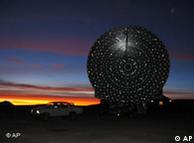Hydrogen peroxide in space suggests water and oxygen, scientists hope

Rho Ophiuchi is rich pickings for scientists seeking molecules
An international team of scientists, including astronomers from the Max
Planck Institute, have discovered molecules in space that are critical
to the creation and sustenance of life on Earth.
European scientists have found evidence of molecules of hydrogen
peroxide within frozen clouds of gas and cosmic dust 400 light years
away.
Their results, published in the July issue of the journal Astronomy
and Astrophysics, highlighted the discovery in a region of our galaxy
where a molecular cloud called Rho Ophiuchi is found.
The molecules were discovered through the use of the Atacama
Pathfinder Experiment telescope (APEX), sitting 5,000 meters (16,400
feet) above sea level on the Chajnantor plateau in Chile. APEX observes
light at millimeter- and submillimeter-wavelengths, which are ideal for
detecting the signals from these molecules.
APEX is a shared telescope between the Max Planck Institute for Radio
Astronomy in Bonn, the Onsala Space Observatory in Sweden, and the
European Southern Observatory.
The team recorded the characteristic signature of light emitted by
hydrogen peroxide coming from part of the extremely cold (-250 degrees
Celsius), dense clouds of cosmic gas and dust in which new stars are
being born.
Unanswered questions
"We don't understand yet how some of the most important molecules
here on Earth are made in space," said Bérengère Parise in a statement.
The French researcher is based at the Max Planck Institute, and is one of the paper's co-authors.
"But our discovery of hydrogen peroxide with APEX seems to be showing
us that cosmic dust is the missing ingredient in the process," she
added.
 Astronomers consider APEX well situated thanks to clear skies above the Chilean plateau Astronomers consider APEX well situated thanks to clear skies above the Chilean plateau
The presence of hydrogen peroxide is significant because it is so
closely related to two other important molecules, water and oxygen.
The discovery goes towards answering one of the pressing questions
that scientists have been asking: where can we find water elsewhere in
the universe?
Vindication
It's a question that Ewine van Dishoeck, an astronomer at Leiden
University in the Netherlands has been trying to answer through her work
with the Herschel Space Observatory.
"I see it as a vindication of theories from the 1980s," van Dishoeck told Deutsche Welle.
She said simulations have been predicting the creation of molecular
bonds between hydrogen and oxygen atoms on the surface of the tiny
grains of cosmic dust within these frigid clouds.
Between the data from APEX and the Herschel Space Observatory, van
Dishoeck said this is a very exciting time for the field of research
into space water. At Herschel, she said, the search continues for
another missing ingredient, molecular oxygen.
Author: Stuart Tiffen
Editor: Cyrus Farivar
http://www.dw-world.de/dw/article/0,,15218462,00.html
| 








